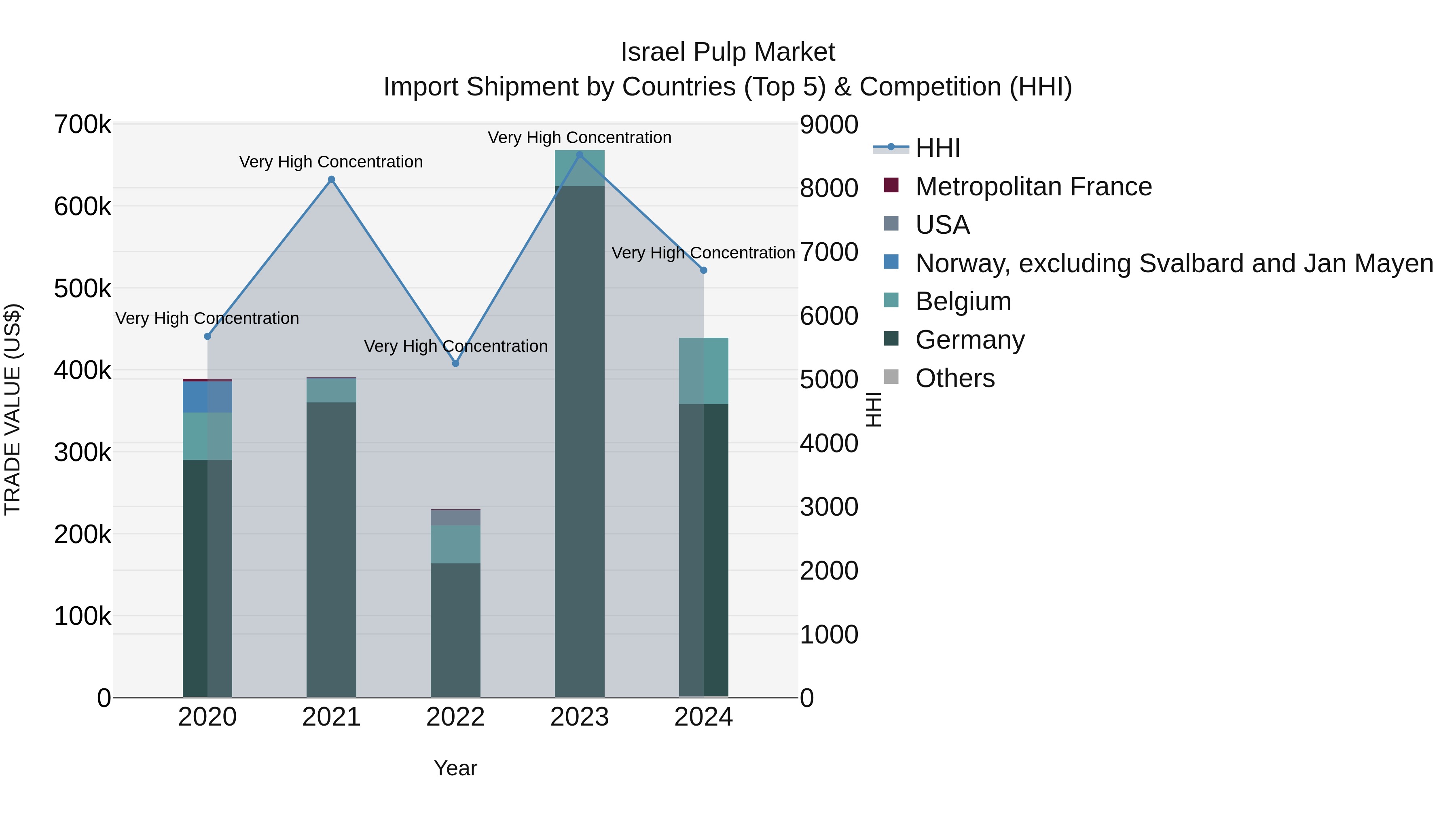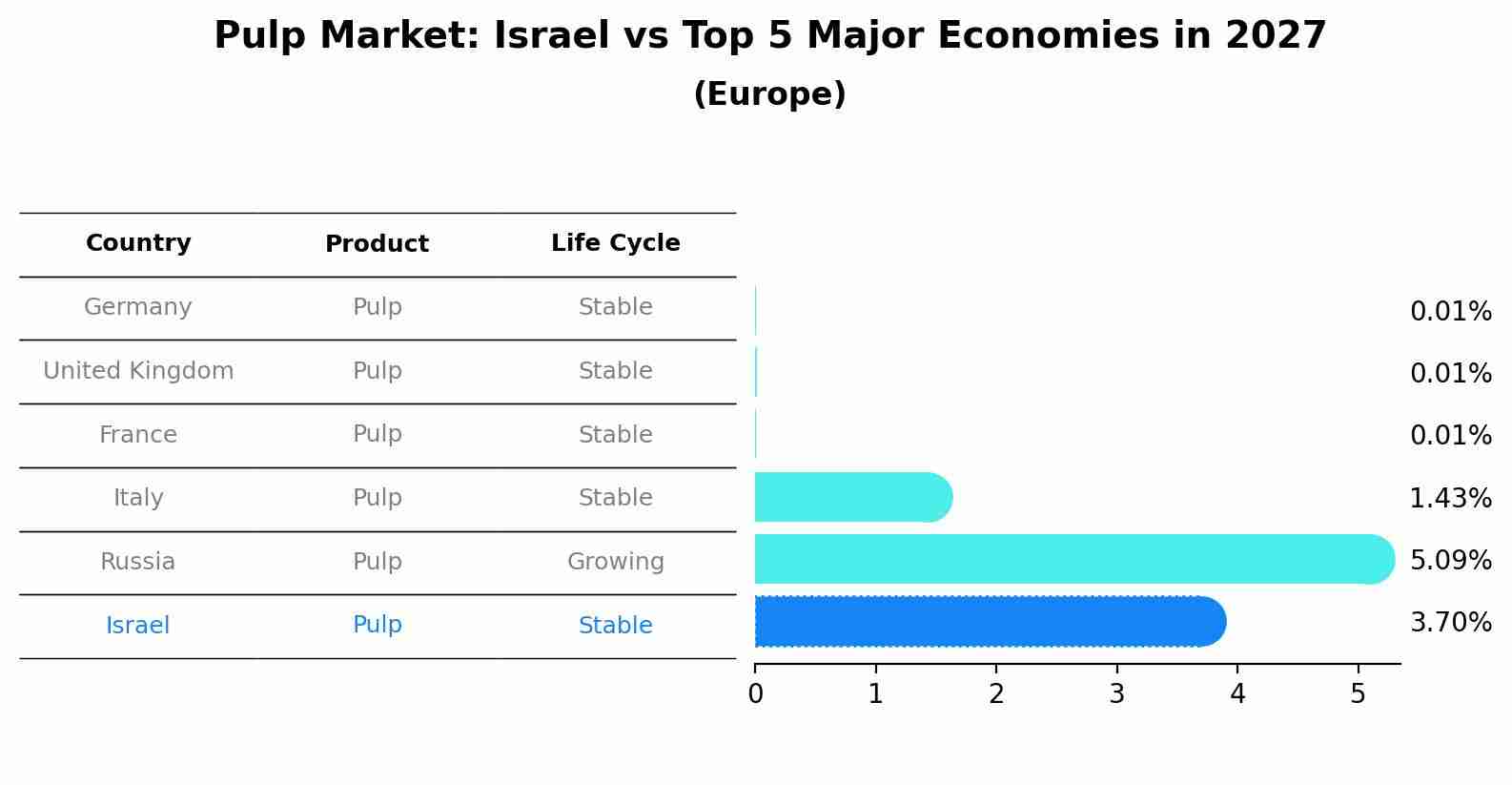Israel Pulp Market (2025-2031) | Share, Outlook, Industry, Companies, Analysis, Revenue, Segmentation, Forecast, Growth, Value, Size & Trends
| Product Code: ETC4650526 | Publication Date: Nov 2023 | Updated Date: Nov 2025 | Product Type: Market Research Report | |
| Publisher: 6Wresearch | Author: Shubham Padhi | No. of Pages: 60 | No. of Figures: 30 | No. of Tables: 5 |
Israel Pulp Market Top 5 Importing Countries and Market Competition (HHI) Analysis
Israel`s pulp import market in 2024 continued to see a high level of concentration, with top exporting countries being Germany, Belgium, Italy, Brazil, and Metropolitan France. Despite a slight decline in growth rate from 2023 to 2024, the compound annual growth rate (CAGR) for the period 2020-2024 remained positive at 3.07%. This data suggests a stable and established market for pulp imports in Israel, with key European and South American countries playing significant roles in supplying the country`s pulp needs.

Pulp Market: Israel vs Top 5 Major Economies in 2027 (Europe)
In the Europe region, the Pulp market in Israel is projected to expand at a stable growth rate of 3.70% by 2027. The largest economy is Germany, followed by United Kingdom, France, Italy and Russia.

Israel Pulp Market Synopsis
The Israel pulp market is a crucial component of the global pulp and paper industry, supplying raw material for various paper and board products. Pulp is derived from wood fibers through mechanical or chemical processes and serves as the foundation for manufacturing paper, packaging, tissues, and other cellulose-based products. The market is influenced by factors such as fluctuating demand, raw material availability, and environmental regulations. Efforts to promote sustainable forestry practices, reduce carbon emissions, and optimize production processes are shaping the future of the pulp market in Israel. Additionally, investments in research and development aim to enhance product quality, efficiency, and cost-effectiveness.
Drivers of the market
The Israel pulp market is witnessing significant growth owing to increasing demand from end-use industries such as packaging, textiles, and hygiene products. Rising consumer awareness regarding sustainable and recyclable packaging solutions is driving market demand for pulp in the region.
Challenges of the market
The pulp market in Israel confronts challenges stemming from environmental sustainability, supply chain resilience, and market volatility. As a primary raw material for various industries including paper, packaging, and textiles, ensuring a stable and sustainable supply of pulp is essential for maintaining production continuity and meeting customer demand. However, factors such as deforestation, climate change, and geopolitical tensions can disrupt pulp supply chains and lead to price fluctuations and supply shortages. Moreover, regulatory pressures to adopt sustainable forestry practices and reduce carbon emissions further complicate market dynamics for pulp producers in Israel, necessitating strategic investments in alternative fiber sources and recycling technologies to enhance resilience and competitiveness.
Government Policy of the market
To ensure the sustainable management of forest resources and promote responsible forestry practices, the Israel government has enacted policies governing the pulp market. These policies include regulations for forest certification, logging practices, and biodiversity conservation to mitigate deforestation and habitat destruction. Additionally, the government supports initiatives to enhance the competitiveness of the pulp industry through investments in infrastructure, technology upgrades, and market development efforts to meet domestic demand and export opportunities while preserving forest ecosystems.
Key Highlights of the Report:
- Israel Pulp Market Outlook
- Market Size of Israel Pulp Market, 2024
- Forecast of Israel Pulp Market, 2031
- Historical Data and Forecast of Israel Pulp Revenues & Volume for the Period 2021-2031
- Israel Pulp Market Trend Evolution
- Israel Pulp Market Drivers and Challenges
- Israel Pulp Price Trends
- Israel Pulp Porter`s Five Forces
- Israel Pulp Industry Life Cycle
- Historical Data and Forecast of Israel Pulp Market Revenues & Volume By Types for the Period 2021-2031
- Historical Data and Forecast of Israel Pulp Market Revenues & Volume By Chemical Pulp for the Period 2021-2031
- Historical Data and Forecast of Israel Pulp Market Revenues & Volume By Mechanical & Semi Chemical Pulp for the Period 2021-2031
- Historical Data and Forecast of Israel Pulp Market Revenues & Volume By Non Wood Pulp for the Period 2021-2031
- Historical Data and Forecast of Israel Pulp Market Revenues & Volume By Applications for the Period 2021-2031
- Historical Data and Forecast of Israel Pulp Market Revenues & Volume By Corrugating Materials for the Period 2021-2031
- Historical Data and Forecast of Israel Pulp Market Revenues & Volume By Printing & Writing for the Period 2021-2031
- Historical Data and Forecast of Israel Pulp Market Revenues & Volume By Carton Board for the Period 2021-2031
- Historical Data and Forecast of Israel Pulp Market Revenues & Volume By Tissue for the Period 2021-2031
- Historical Data and Forecast of Israel Pulp Market Revenues & Volume By Newsprint for the Period 2021-2031
- Historical Data and Forecast of Israel Pulp Market Revenues & Volume By Wrapping Paper for the Period 2021-2031
- Historical Data and Forecast of Israel Pulp Market Revenues & Volume By Kraft Paper for the Period 2021-2031
- Israel Pulp Import Export Trade Statistics
- Market Opportunity Assessment By Types
- Market Opportunity Assessment By Applications
- Israel Pulp Top Companies Market Share
- Israel Pulp Competitive Benchmarking By Technical and Operational Parameters
- Israel Pulp Company Profiles
- Israel Pulp Key Strategic Recommendations
Frequently Asked Questions About the Market Study (FAQs):
1 Executive Summary |
2 Introduction |
2.1 Key Highlights of the Report |
2.2 Report Description |
2.3 Market Scope & Segmentation |
2.4 Research Methodology |
2.5 Assumptions |
3 Israel Pulp Market Overview |
3.1 Israel Country Macro Economic Indicators |
3.2 Israel Pulp Market Revenues & Volume, 2021 & 2031F |
3.3 Israel Pulp Market - Industry Life Cycle |
3.4 Israel Pulp Market - Porter's Five Forces |
3.5 Israel Pulp Market Revenues & Volume Share Segmentations, 2021 & 2031F |
3.6 Israel Pulp Market Revenues & Volume Share, By Applications, 2021 & 2031F |
4 Israel Pulp Market Dynamics |
4.1 Impact Analysis |
4.2 Market Drivers |
4.2.1 Increasing demand for sustainable packaging solutions |
4.2.2 Growing awareness about environmental conservation and recycling |
4.2.3 Technological advancements in pulp production processes |
4.3 Market Restraints |
4.3.1 Fluctuating raw material prices |
4.3.2 Regulatory challenges related to environmental standards and certifications |
5 Israel Pulp Market Trends |
6 Israel Pulp Market Segmentations |
6.1 Israel Pulp Market Segmentations |
6.1.1 Overview and Analysis |
6.1.2 Israel Pulp Market Revenues & Volume, By Chemical Pulp, 2021-2031F |
6.1.3 Israel Pulp Market Revenues & Volume, By Mechanical & Semi Chemical Pulp, 2021-2031F |
6.1.4 Israel Pulp Market Revenues & Volume, By Non Wood Pulp, 2021-2031F |
6.2 Israel Pulp Market, By Applications |
6.2.1 Overview and Analysis |
6.2.2 Israel Pulp Market Revenues & Volume, By Corrugating Materials, 2021-2031F |
6.2.3 Israel Pulp Market Revenues & Volume, By Printing & Writing, 2021-2031F |
6.2.4 Israel Pulp Market Revenues & Volume, By Carton Board, 2021-2031F |
6.2.5 Israel Pulp Market Revenues & Volume, By Tissue, 2021-2031F |
6.2.6 Israel Pulp Market Revenues & Volume, By Newsprint, 2021-2031F |
6.2.7 Israel Pulp Market Revenues & Volume, By Wrapping Paper, 2021-2031F |
7 Israel Pulp Market Import-Export Trade Statistics |
7.1 Israel Pulp Market Export to Major Countries |
7.2 Israel Pulp Market Imports from Major Countries |
8 Israel Pulp Market Key Performance Indicators |
8.1 Percentage of recycled content in pulp production |
8.2 Energy efficiency in pulp manufacturing processes |
8.3 Adoption rate of sustainable packaging solutions in the market |
9 Israel Pulp Market - Opportunity Assessment |
9.1 Israel Pulp Market Opportunity Assessment Segmentations, 2021 & 2031F |
9.2 Israel Pulp Market Opportunity Assessment, By Applications, 2021 & 2031F |
10 Israel Pulp Market - Competitive Landscape |
10.1 Israel Pulp Market Revenue Share, By Companies, 2024 |
10.2 Israel Pulp Market Competitive Benchmarking, By Operating and Technical Parameters |
11 Company Profiles |
12 Recommendations | 13 Disclaimer |
- Single User License$ 1,995
- Department License$ 2,400
- Site License$ 3,120
- Global License$ 3,795
Search
Thought Leadership and Analyst Meet
Our Clients
Related Reports
- Germany Breakfast Food Market (2026-2032) | Industry, Share, Growth, Size, Companies, Value, Analysis, Revenue, Trends, Forecast & Outlook
- Australia Briquette Market (2025-2031) | Growth, Size, Revenue, Forecast, Analysis, Trends, Value, Share, Industry & Companies
- Vietnam System Integrator Market (2025-2031) | Size, Companies, Analysis, Industry, Value, Forecast, Growth, Trends, Revenue & Share
- ASEAN and Thailand Brain Health Supplements Market (2025-2031) | Strategy, Consumer Insights, Analysis, Investment Trends, Opportunities, Growth, Size, Share, Industry, Revenue, Segments, Value, Segmentation, Supply, Forecast, Restraints, Outlook, Competition, Drivers, Trends, Demand, Pricing Analysis, Competitive, Strategic Insights, Companies, Challenges
- ASEAN Bearings Market (2025-2031) | Strategy, Consumer Insights, Analysis, Investment Trends, Opportunities, Growth, Size, Share, Industry, Revenue, Segments, Value, Segmentation, Supply, Forecast, Restraints, Outlook, Competition, Drivers, Trends, Demand, Pricing Analysis, Competitive, Strategic Insights, Companies, Challenges
- Europe Flooring Market (2025-2031) | Outlook, Share, Industry, Trends, Forecast, Companies, Revenue, Size, Analysis, Growth & Value
- Saudi Arabia Manlift Market (2025-2031) | Outlook, Size, Growth, Trends, Companies, Industry, Revenue, Value, Share, Forecast & Analysis
- Uganda Excavator, Crane, and Wheel Loaders Market (2025-2031) | Strategy, Consumer Insights, Analysis, Investment Trends, Opportunities, Growth, Size, Share, Industry, Revenue, Segments, Value, Segmentation, Supply, Forecast, Restraints, Outlook, Competition, Drivers, Trends, Demand, Pricing Analysis, Competitive, Strategic Insights, Companies, Challenges
- Rwanda Excavator, Crane, and Wheel Loaders Market (2025-2031) | Strategy, Consumer Insights, Analysis, Investment Trends, Opportunities, Growth, Size, Share, Industry, Revenue, Segments, Value, Segmentation, Supply, Forecast, Restraints, Outlook, Competition, Drivers, Trends, Demand, Pricing Analysis, Competitive, Strategic Insights, Companies, Challenges
- Kenya Excavator, Crane, and Wheel Loaders Market (2025-2031) | Strategy, Consumer Insights, Analysis, Investment Trends, Opportunities, Growth, Size, Share, Industry, Revenue, Segments, Value, Segmentation, Supply, Forecast, Restraints, Outlook, Competition, Drivers, Trends, Demand, Pricing Analysis, Competitive, Strategic Insights, Companies, Challenges
Industry Events and Analyst Meet
Whitepaper
- Middle East & Africa Commercial Security Market Click here to view more.
- Middle East & Africa Fire Safety Systems & Equipment Market Click here to view more.
- GCC Drone Market Click here to view more.
- Middle East Lighting Fixture Market Click here to view more.
- GCC Physical & Perimeter Security Market Click here to view more.
6WResearch In News
- Doha a strategic location for EV manufacturing hub: IPA Qatar
- Demand for luxury TVs surging in the GCC, says Samsung
- Empowering Growth: The Thriving Journey of Bangladesh’s Cable Industry
- Demand for luxury TVs surging in the GCC, says Samsung
- Video call with a traditional healer? Once unthinkable, it’s now common in South Africa
- Intelligent Buildings To Smooth GCC’s Path To Net Zero


















